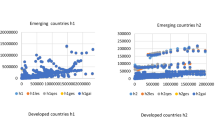Abstract
The paper derives a complete system ofdemand equations for public consumptionexpenditures as the outcome of rationalbehaviour in a model where governmentmaximizes expected electoral support. Theallocation of expenditures is found todepend not only on the prices of publicservices and total expenditure and tosatisfy the constraints of demand theory,which have been the focus of attention ofprevious empirical studies of theallocation of public expenditures, but, inaddition, on the prices of privateconsumption goods, the distribution ofvoter incomes and the expected change invoter support from varying the levels ofpublic provision.
Similar content being viewed by others
References
Adams, J. (1999). Multiparty spatial competition with probabilistic voting. Public Choice 99: 259-274.
Barr, J. L. and Davies, O.A. (1966). An elementary political and economic theory of the expenditure of local governments. Southern Economic Journal 33: 149-165.
Bergstrom, T.C. and Goodman, R.P. (1973). Private demands for public goods. American Economic Review 63: 280-296.
Borcherding, T.E. and Deacon, R.T. (1972). The demand for the services of non-federal governments. American Economic Review 62: 891-901.
Coyote, P.C. and Landon, S. (1990). Cost-sharing versus block funding in a federal system: A demand systems approach. Canadian Journal of Economics 23: 817-838.
Coughlin, P. J. (1992). Probabilistic voting theory. Cambridge: Cambridge University Press.
Coughlin, P.J., Mueller, D.C. and Murrell, P. (1990). A model of electoral competition with interest groups. Economics Letters 32: 307-311.
Coughlin, P.J. and Nitzan, S. (1981). Electoral outcomes with probabilistic voting and Nash social welfare maxima. Journal of Public Economics 15: 113-121.
Deacon, R.T. (1978). A demand model for the local public sector. Review of Economics and Statistics 60: 180-202.
Deaton, A. and Muellbauer, J. (1980). Economics and consumer behaviour. Cambridge: Cambridge University Press.
Denzau, A.T. and Parks, R.P. (1979). Deriving public sector preferences. Journal of Public Economics 11: 335-352.
Dunne, J.P., Pashardes, P. and Smith, R.P. (1984). Needs, costs and bureaucracy: The allocation of public consumption in the U.K. Economic Journal 94: 1-15.
Dunne, J.P. and Smith, R.P. (1984). The allocative efficiency of government expenditure: Some comparative tests. European Economic Review 20: 381-394.
Enelow, J.M. and Hinich, M.J. (1989). A general probabilistic theory of elections. Public Choice 61: 101-113.
Haynes, K. and Grosskopf, S. (1984). The role of functional form in estimating the demand for local public goods. Review of Economics and Statistics 66: 63-179.
Hettich, W. and Winer, S.L. (1988). Economic and political foundation of tax structure. American Economic Review 78: 701-712.
Hettich, W. and Winer, S.L. (1999). Democratic choice and taxation. Cambridge: Cambridge University Press.
Kirchgässner, G. (2000). Probabilistic voting and equilibrium: An impossibility result. Public Choice 103: 35-48.
Lin T-M., Enelow, J.M. and Dorussen, H. (1999). Equilibrium in multicandidate probabilistic spatial voting. Public Choice 98: 59-82.
McMillan, M.L. and Amoako-Tuffour, J. (1988). An examination of preferences for local public sector outputs. Review of Economics and Statistics 70: 45-54.
Pitarakis, J.-Y. and Tridimas, G. (1999). Total expenditure endogeneity and the allocation of public consumption expenditure in the U.K. Economic Modelling 16: 279-291.
Tanzi, V. and Schuknecht, L. (2000). Public spending in the 20th century: A global perspective. Cambridge: Cambridge University Press.
Tridimas, G. (1985). Economic theory and the allocation of public expenditures in Greece. Greek Economic Review 7: 34-52.
Tridimas, G. (1999). A demand-theoretic analysis of public consumption priorities in the U.K. Public Finance Review 27: 599-623.
Tridimas, G. (2000a). Consumer demand and public consumption expenditure in the U.K. Unpublished manuscript.
Tridimas, G. (2000b). Public provision and administration costs under political equilibrium. Processed.
Usher, D. (1994). The significance of the probabilistic voting theorem. Canadian Journal of Economics 27: 433-445.
Warskett, G., Winer, S.L. and Hettich, W. (1998). The complexity of tax structures in competitive political systems. International Tax and Public Finance 5: 123-151.
Winer, S.L. and Hettich, W. (1998). What is missed if we leave out collective choice in the analysis of taxation? National Tax Journal 51: 372-389.
Author information
Authors and Affiliations
Rights and permissions
About this article
Cite this article
Tridimas, G. The Economics and Politics of the Structure of Public Expenditure. Public Choice 106, 299–316 (2001). https://doi.org/10.1023/A:1005250716104
Issue Date:
DOI: https://doi.org/10.1023/A:1005250716104




